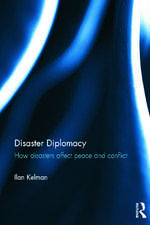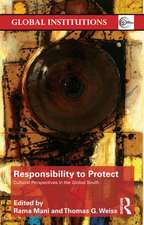Constructing Genocide and Mass Violence: Society, Crisis, Identity: Routledge Studies in Genocide and Crimes against Humanity
Autor Maureen S. Hieberten Limba Engleză Paperback – 4 feb 2019
Hiebert answers these questions by exploring the structures and processes that underpin the decision by political elites to commit genocide, focusing on a sustained comparison of two cases, the Nazi ' Final Solution' and the Cambodian genocide. The book clearly differentiates the structures and processes - contained within a larger overall process - that leads to genocidal violence. Uncovering the mechanisms by which societies (at least in the contemporary era) come to experience genocide as a distinct form of destruction and not some other form of mass or political violence, Hiebert is able to highlight a set of key process that lead to specifically genocidal violence.
Providing an insightful contribution to the burgeoning literature in this area, this book will be of interest to students and scholars of genocide, international relations, and political violence.
| Toate formatele și edițiile | Preț | Express |
|---|---|---|
| Paperback (1) | 412.37 lei 6-8 săpt. | |
| Taylor & Francis – 4 feb 2019 | 412.37 lei 6-8 săpt. | |
| Hardback (1) | 1001.84 lei 6-8 săpt. | |
| Taylor & Francis – 17 mar 2017 | 1001.84 lei 6-8 săpt. |
Preț: 412.37 lei
Nou
Puncte Express: 619
Preț estimativ în valută:
78.91€ • 82.59$ • 65.68£
78.91€ • 82.59$ • 65.68£
Carte tipărită la comandă
Livrare economică 31 martie-14 aprilie
Preluare comenzi: 021 569.72.76
Specificații
ISBN-13: 9780367195014
ISBN-10: 0367195011
Pagini: 242
Dimensiuni: 156 x 234 x 13 mm
Greutate: 0.36 kg
Ediția:1
Editura: Taylor & Francis
Colecția Routledge
Seria Routledge Studies in Genocide and Crimes against Humanity
Locul publicării:Oxford, United Kingdom
ISBN-10: 0367195011
Pagini: 242
Dimensiuni: 156 x 234 x 13 mm
Greutate: 0.36 kg
Ediția:1
Editura: Taylor & Francis
Colecția Routledge
Seria Routledge Studies in Genocide and Crimes against Humanity
Locul publicării:Oxford, United Kingdom
Public țintă
Postgraduate and UndergraduateCuprins
Chapter 1: The genocidal process: a constructivist approach
Introduction
Part I: Theorizing the "permissive" socio-political environment of genocide
Introduction
I. The ‘permissive’ socio-political environment: a theoretical overview
II. Three dimensions of the permissive socio-political environment of genocide
Chapter 2: Germany
I. Exclusionary and unequal patterns of group interaction
II. Exclusionary conceptions of the community
III. Authoritarian modes of conflict management
Chapter 3: Cambodia
I. Exclusionary and unequal patterns of group interaction
II. Exclusionary conceptions of the community
III. Authoritarian modes of conflict management
Conclusion to Part I
Part II: Introduction crises and interpretation: the catalyst for killing
Introduction
Chapter 4: Inter-war Germany: crises and interpretation
I. Security crises
II. Economic crises
III. Political crises
Chapter 5: Cambodia: the Sihanoukist and Lon Nol years: crises and interpretation
I. Economic crises
II. Political crises
III. Military and security crises
Conclusion to Part II
Part III: Reconceptualizing the victim group: the "three switches" of genocide
Introduction
I. Genocide as a strategic or rational choice?
II. Constructing victims: a constructivist explanation
III. The "three switches"
III. Warrants for genocide
Chapter 6: Nazi final solution
I. Switch one: victims as foreigners
II. Switch two: victims as mortal threats
III. Switch three: victims as sub-humans
Chapter 7: The Khmer Rouge killing fields
I. Switch one: victims as foreigners
II. Switch two: victims as mortal threat
III. Switch three:victims as sub-humans
Chapter 8: Vietnam: abuses without genocide
I. Switch one: victims as wayward opponents
II. Switch two: the threat of actors with real power
Conclusion to Part III
Introduction
Part I: Theorizing the "permissive" socio-political environment of genocide
Introduction
I. The ‘permissive’ socio-political environment: a theoretical overview
II. Three dimensions of the permissive socio-political environment of genocide
Chapter 2: Germany
I. Exclusionary and unequal patterns of group interaction
II. Exclusionary conceptions of the community
III. Authoritarian modes of conflict management
Chapter 3: Cambodia
I. Exclusionary and unequal patterns of group interaction
II. Exclusionary conceptions of the community
III. Authoritarian modes of conflict management
Conclusion to Part I
Part II: Introduction crises and interpretation: the catalyst for killing
Introduction
Chapter 4: Inter-war Germany: crises and interpretation
I. Security crises
II. Economic crises
III. Political crises
Chapter 5: Cambodia: the Sihanoukist and Lon Nol years: crises and interpretation
I. Economic crises
II. Political crises
III. Military and security crises
Conclusion to Part II
Part III: Reconceptualizing the victim group: the "three switches" of genocide
Introduction
I. Genocide as a strategic or rational choice?
II. Constructing victims: a constructivist explanation
III. The "three switches"
III. Warrants for genocide
Chapter 6: Nazi final solution
I. Switch one: victims as foreigners
II. Switch two: victims as mortal threats
III. Switch three: victims as sub-humans
Chapter 7: The Khmer Rouge killing fields
I. Switch one: victims as foreigners
II. Switch two: victims as mortal threat
III. Switch three:victims as sub-humans
Chapter 8: Vietnam: abuses without genocide
I. Switch one: victims as wayward opponents
II. Switch two: the threat of actors with real power
Conclusion to Part III
Notă biografică
Maureen S. Hiebert is Associate Professor in the Department of Political Science and Senior Research Fellow in the Centre for Military, Security and Strategic Studies at the University of Calgary, Canada.
Descriere
This work seeks to address two closely related questions, what is the process by which the relatively short and violent genocides of the twentieth century and beyond have occurred and why have these instances of mass violence been genocidal and not some other form of state violence, repression, or conflict?



























